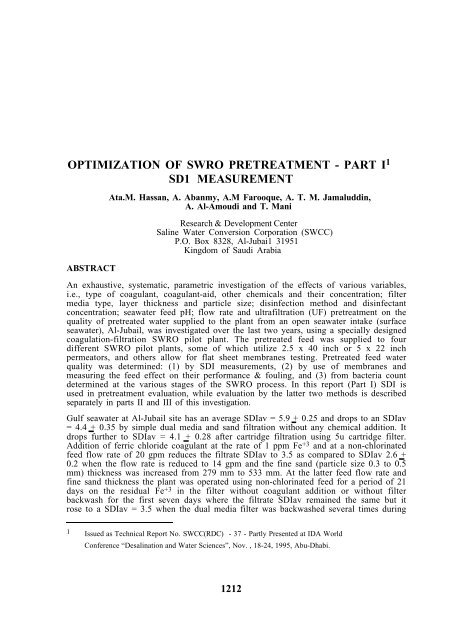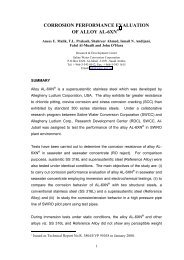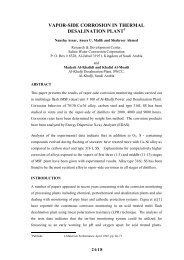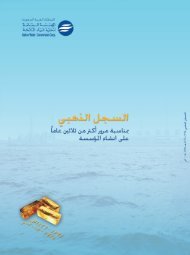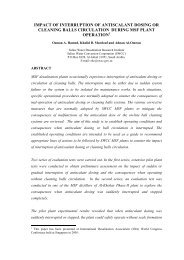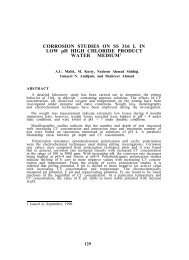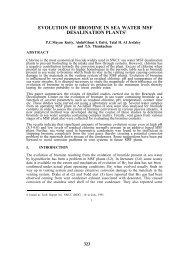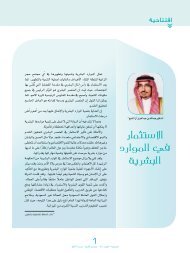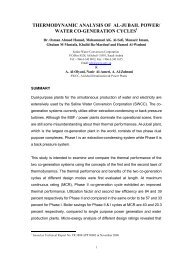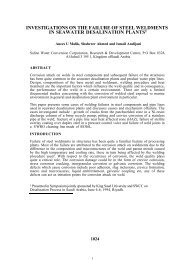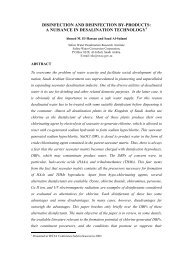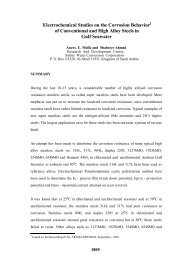OPTIMIZATION OF SWRO PRETREATMENT - PART I1 SD1 ...
OPTIMIZATION OF SWRO PRETREATMENT - PART I1 SD1 ...
OPTIMIZATION OF SWRO PRETREATMENT - PART I1 SD1 ...
Create successful ePaper yourself
Turn your PDF publications into a flip-book with our unique Google optimized e-Paper software.
<strong>OPTIMIZATION</strong> <strong>OF</strong> <strong>SWRO</strong> <strong>PRETREATMENT</strong> - <strong>PART</strong> I 1<br />
<strong>SD1</strong> MEASUREMENT<br />
ABSTRACT<br />
Ata.M. Hassan, A. Abanmy, A.M Farooque, A. T. M. Jamaluddin,<br />
A. Al-Amoudi and T. Mani<br />
Research & Development Center<br />
Saline Water Conversion Corporation (SWCC)<br />
P.O. Box 8328, Al-Jubai1 31951<br />
Kingdom of Saudi Arabia<br />
An exhaustive, systematic, parametric investigation of the effects of various variables,<br />
i.e., type of coagulant, coagulant-aid, other chemicals and their concentration; filter<br />
media type, layer thickness and particle size; disinfection method and disinfectant<br />
concentration; seawater feed pH; flow rate and ultrafiltration (UF) pretreatment on the<br />
quality of pretreated water supplied to the plant from an open seawater intake (surface<br />
seawater), Al-Jubail, was investigated over the last two years, using a specially designed<br />
coagulation-filtration <strong>SWRO</strong> pilot plant. The pretreated feed was supplied to four<br />
different <strong>SWRO</strong> pilot plants, some of which utilize 2.5 x 40 inch or 5 x 22 inch<br />
permeators, and others allow for flat sheet membranes testing. Pretreated feed water<br />
quality was determined: (1) by SDI measurements, (2) by use of membranes and<br />
measuring the feed effect on their performance & fouling, and (3) from bacteria count<br />
determined at the various stages of the <strong>SWRO</strong> process. In this report (Part I) SDI is<br />
used in pretreatment evaluation, while evaluation by the latter two methods is described<br />
separately in parts II and III of this investigation.<br />
Gulf seawater at Al-Jubail site has an average SDIav = 5.9 + 0.25 and drops to an SDIav<br />
= 4.4 + 0.35 by simple dual media and sand filtration without any chemical addition. It<br />
drops further to SDIav = 4.1 + 0.28 after cartridge filtration using 5u cartridge filter.<br />
Addition of ferric chloride coagulant at the rate of 1 ppm Fe +3 and at a non-chlorinated<br />
feed flow rate of 20 gpm reduces the filtrate SDIav to 3.5 as compared to SDIav 2.6 +<br />
0.2 when the flow rate is reduced to 14 gpm and the fine sand (particle size 0.3 to 0.5<br />
mm) thickness was increased from 279 mm to 533 mm. At the latter feed flow rate and<br />
fine sand thickness the plant was operated using non-chlorinated feed for a period of 21<br />
days on the residual Fe +3 in the filter without coagulant addition or without filter<br />
backwash for the first seven days where the filtrate SDIav remained the same but it<br />
rose to a SDIav = 3.5 when the dual media filter was backwashed several times during<br />
1 Issued as Technical Report No. SWCC(RDC) - 37 - Partly Presented at IDA World<br />
Conference “Desalination and Water Sciences”, Nov. , 18-24, 1995, Abu-Dhabi.<br />
1212
the last 14 days. The residual Fe +3 remaining within the dual media filter and sand filter<br />
layers are sufficiently large to provide the coagulation without the addition of new<br />
coagulant. This suggest that at this rate of Fe +3 dosing the filter back washing is not<br />
removing all the Fe +3 ions. Furthermore, the results suggest the possibility that the<br />
pretreatment may be operated at lower coagulant dosing rates which is being tried, or<br />
alternatively by a programmed gradual reduction in Fe +3 dosing ratio. This should<br />
further reduce the Fe +3 ions in the feed and minimize their precipitation on the<br />
membrane surface.<br />
Dosing of both coagulant (Fe +3 = 1 ppm) and coagulant-aid (polyelectrolyte = 0.8 ppm)<br />
reduces the sand filtrate to an SDIav = 1.9 but it leads to a noticeable increases in<br />
bacterial count if the residual chlorine in the feed is low, less than about 1.0 ppm. A<br />
major reduction in SDI to about 1 or less was obtained by passing the seawater or the<br />
filtrate feed through ultrafiltration (UF) unit with a molecular weight (MW) cut-off of<br />
15000. However, frequent backwashing is required in the former case. Due to chlorine<br />
degradation of micro-organisms and other organics, the chlorinated feed tends to have<br />
higher SDI value, at least by one unit, than the similarly treated but non-chlorinated<br />
feed. Dosing of acid in seawater ahead of the filtration step has no major effect on<br />
filtrate SDI when compared to the SDI of nonacidified filtrates.<br />
INTRODUCTION<br />
The membrane is the heart of the RO plant and is made of special semipermeable thin<br />
polymeric film deposited on a relatively thick strong support material or made of a thin<br />
polymeric film of the same composition as its strong support material. Membranes are<br />
characterized by their unique properties of high water permeation (flow), very low salt<br />
passage and dimensional and chemical stability. In spite of their small sizes and high<br />
solubilities in water, salts, even those with small molecular weights, do not pass<br />
through the membrane at a significant rate. Their passage is held to a very low level,<br />
e.g., less than 1% using thin film composite (TFC) seawater membranes. Passage of<br />
the larger size colloidal and other suspended solid particles is not permitted at all<br />
through the membrane closed structure. This is also true of microorganism such as<br />
bacteria which, when present in the feed, will be trapped on the membrane surface<br />
causing it to foul Membrane fouling is also introduced by the presence in the feed of<br />
scaling and corrosion products. The presence of any of the above matters in the feed<br />
could cause membrane fouling and the lowering of the RO plant efficiency, hence feed<br />
pretreatment is required.<br />
In water desalination by the RO process feed water pretreatment is essential in order to<br />
remove all the potential membrane foulants from the feed. The degree of pretreatment,<br />
however, is dependent on the raw water quality, particularly its content of suspended<br />
and biological matter as well as on the membrane configuration. Water quality tends to<br />
1213
e site dependent. For example, the average SDI values of raw, untreated feed to<br />
SWCC <strong>SWRO</strong> plants located on the shore of the Red Sea are:<br />
SDI = 4.6 Haql, Duba, Umm Lujj,<br />
SDI = 4.75 Jeddah - I, and<br />
SDI = 6.5 Al-Birk [l&2]<br />
By comparison the average SDI values for the untreated Gulf seawater are:<br />
SDI = 5.9 at SWCC Jubail, and<br />
SDI = 6.5 or more at Doha, Kuwait [3]<br />
High SDI values are also reported for untreated seawater at Al-Dur, Bahrain. (The SDI<br />
(4) is a measure of water clarity, the lower the SDI value the greater is its clarity and<br />
the lesser suspended matter it contains.<br />
Membrane configuration has a great influence on the degree of seawater pretreatment.<br />
Hollow line fiber (HFF) membrane configuration with tight fiber packing in the module<br />
requires maximum pretreatment as compared to an intermediate and modest degrees of<br />
pretreatment for the spiral wound (SW) and plate & frame (PF) membrane<br />
configurations, respectively. The manufacturers recommend different treatment for<br />
each of the above configurations. The pretreatment should be able to yield a feed with<br />
the following SDI values:<br />
SDI < 3 for HFF with high fiber packing density,<br />
SDI < 4 for SW, and HFF with moderate fiber packing<br />
density,<br />
SDI < 5 for PF membranes.<br />
An ideal pretreatment is designed to cause a minimum or no membrane fouling at the<br />
lowest possible cost. This not only results in longer membrane life but also improves<br />
the overall plant efficiency and reduces the cost of fresh water production. Seawater<br />
feed derived from a well-designed well requires minimum of pretreatment by passing it<br />
only through cartridge filter, size 5 to 15m. The feed tends to be a high quality feed<br />
with an SDI as low as 1 or less. In this case natural filtration cleans the water from<br />
nearly all foulants. The ultrafiltration and microfiltration membrane processes are<br />
being tried instead of the classical <strong>SWRO</strong> pretreatment of coagulation-filtration process.<br />
Experiments done at our laboratory with ultrafiltration pretreatment gave pretreated<br />
feed with SDI of less than 1. Although the well-designed beachwell and the filtration<br />
membrane processes yield pretreated feed with very low SDI, the treatment does not<br />
prevent membrane scaling which arises from the concentration to their solubility limits<br />
of sparingly soluble salts, e.g., CaSO 4 , CaCO 3 , etc. To attain high water recovery,<br />
antiscalant needs to be added to feed containing salts with scaling tendency.<br />
Pretreatment of surface seawater, however, is rather more demanding than that of well<br />
water or membrane treated feed and depends on the feed water quality. The feed<br />
1214
treatment may consist of disinfection, followed by coagulation-flocculation filtration<br />
and dosing of antiscalant. Feed chlorination and dechlorination is also required when<br />
the feed is intended for chlorine sensitive membranes while antiscalant agents are added<br />
as needed.<br />
High quality feed with SDI value less than 3 and in some cases as low as 1 is obtained<br />
with a reasonable pretreatment (coagulation-filtration) at SWCC Haql <strong>SWRO</strong> plant.<br />
This tends to be true of SWCC <strong>SWRO</strong> plants located on the Red Sea at Duba and<br />
Jeddah where for both cases <strong>SD1</strong> tends to be less than 3 when ferric coagulant is added<br />
to the feed ahead of the dual media filter. Higher <strong>SD1</strong> values of 3 to 4 are obtained for<br />
filtrate without coagulant addition at SWCC Umm Lujj <strong>SWRO</strong> plant [I]. In all above<br />
cases no membrane fouling has been reported. By comparison much higher SDI values<br />
greater than 3 are reported for Gulf seawater even when the Fe +3 = 1 ppm coagulant is<br />
added to the feed [3].<br />
Earlier work utilizing an experimental RO pretreatment plant to treat Gulf seawater at<br />
Doha and Shuwaikh, Kuwait (SDI ~ 6 to 6.5) showed that good quality feed with SDI ~<br />
3 to 4 was obtained by in-line coagulation, dosing 1 ppm Fe +3 coagulant followed by<br />
dual media pressure filtration. Both ferric chloride (FeCI 3 ) and FeClSO 4 serve equally<br />
well as coagulant sources. Addition of 1 ppm of the coagulant-aid, polyelectrolyte,<br />
reduced the gradual build-up in pressure across the dual media filter, leading to a<br />
lowering in the frequency of filter backwash (3].<br />
The feed water SDI was reduced to less than 2 using as low as 0.5 mg/L Fe +3 and 20<br />
mg/L acid by passing the filtrate from the dual media pressure filter having 20 cm thick<br />
sand layer of 0.6 to 0.8 mm particle size through a second filter with a finer sand layer,<br />
thickness 60 cm, particle size 0.3 to 0.5 mm [5].<br />
For more turbid Gulf Seawater with SDI = 6.5, feed water with SDI = 3.5 to 4 was<br />
obtained by dosing of 2 to 3 ppm Fe +3 and 0.3 to 0.5 ppm polyelectrolyte followed by<br />
coagulation - flocculation and filtration through dual media gravity filters. The filter is<br />
made of sand layer, thickness 100 cm, particle size 0.7 to 1.2 mm topped with a second<br />
hydroanthracite layer, thickness 70 cm and particle size 1.4 to 2.5 mm [3, 6 & 7]. The<br />
above pretreatment in which energy was used to control the destabilization step was<br />
found to be sufficient for the treatment of feed to the 1000 m 3 /d seawater Doha (Kuwait)<br />
RO line utilizing Fluid System UOP thin film composite polyamide/polyurea membrane<br />
and to a second line 1000 m 3 /d PF RO, at the same pilot plant 2 utilizing thin film<br />
composite Filmtec polyamide flat membrane in about one third of the modules and<br />
cellulose acetate type flat membranes in the remaining modules. The feed to a third<br />
2 Actually this pilot plant because of its large capacity can be considered as a<br />
commercial production plant.<br />
1215
line of 1000 m 3 /d HFF RO line within the same pilot plant, utilizing DuPont B-10<br />
polyamide membrane, however, required additional in-line coagulation and sand<br />
filtration to reduce the SDI < 3. Passage of the pretreated, chlorinated feed through<br />
active carbon filter after dosing sodium bisulfite was satisfactory in the removal of<br />
chlorine from the feed to the highly chlorine sensitive the older UOP membrane (UOP<br />
TFC polyamide-polyurea 1501 PA) [8]. We were told that this is the only UOP plant of<br />
its type which is operated with chlorinated/dechlorinated feed [9] while in other plants<br />
using TFC 1501 PA, CuSO 4 is generally used for disinfection. Unlike the old TFC<br />
UOP membrane the new UOP TFCL type membranes can be operated with a<br />
chlorination/dechlorination treatment. The above pretreatment at Doha <strong>SWRO</strong> pilot<br />
plant yielded good quality feed water in accordance with membrane manufacturers<br />
recommendation which in turn resulted in reduction in the frequency of membranes<br />
cleaning, maintaining design recovery and in an increase in RO plants availability [10<br />
to [3].<br />
Contrary to the above success at Doha Seawater RO plant, Kuwait, a steady decline in<br />
the performance of Al-Birk, 2275 m 3 /d seawater RO plant due to membrane fouling was<br />
observed by SWCC [I, 14]. Similar fouling was also reported at Key West (Florida,<br />
USA), Malta and Ras Tanjib (Saudi Arabia). On the other hand no biological<br />
membrane fouling was observed at the 4400 m 3 /d Umm Lujj RO plant where 0.5 ppm<br />
copper sulfate was added to the surface seawater feed [1, 14]. Moreover, no biofouling<br />
was observed at the 15 mgd Jeddah <strong>SWRO</strong> plant nor at the Haql and Duba plants which<br />
all utilize Toyobo CTA Hollosep HFF membranes and are fed chlorinated, Fe +3 -<br />
coagulated and dual media filtered feed (SDI = 1 to 3) [I]. Polymer degradation, i.e.,<br />
chain scission (cutting the chain into parts), however, was reported at Jeddah I <strong>SWRO</strong><br />
plant due to excess of chlorine in the feed of more than 0.2 ppm in presence of heavy<br />
metals, e.g., copper ions [15]. To avoid CTA polymer degradation by chlorine,<br />
intermittent chlorine dosing in the feed is being tried at Jeddah I <strong>SWRO</strong> test plant [16].<br />
After one year of successful operation, no decline was observed in the performance of<br />
the 46000 m 3 /d RO plant at Ra’s Abu Jarjur, Bahrain [17]. The product water quality<br />
remained higher than design values. Early problem arising from the growth of algae<br />
and bacteria in the filter was remedied by proper disinfection and backwashing of the<br />
filters and also by painting of the GRP pipes to mask their transparency and to protect<br />
them from sun light. The success at this plant which treats a high salinity underground<br />
water, TDS ~13000 ppm, is attributed to high quality feed, <strong>SD1</strong> < 1.5, derived from 15<br />
wells. The pretreatment consists only of simple filtration through dual media filter<br />
followed by active carbon filter to remove trace oil < 0.1 mg/L from the feed. In-line<br />
coagulation which was tried at the start of the plant was found unnecessary [17].<br />
The conclusion that can be drawn from the above review is that pretreatment is an<br />
essential step in the <strong>SWRO</strong> process in order to remove all potential membrane foulants<br />
and prevent membrane degradation and damage by oxidizing agents, e.g., CI 2 present in<br />
1216
the feed. The pretreatment itself is dependent on the feed water quality, membrane type<br />
and configuration and is very much site dependent. Optimization of the pretreatment<br />
for a given type of membrane is very essential for its optimum performance and the<br />
membrane life. An exhaustive, systematic study was carried out to optimize the<br />
coagulation-filtration <strong>SWRO</strong> pretreatment for Gulf seawater taken from an open intake.<br />
Al-Jubail, Saudi Arabia, by investigating the effects of the following pretreatment<br />
variables on feed water quality:<br />
• Feed Flow rate.<br />
• Type of coagulant and coagulant-aid and their concentration,<br />
• Other chemicals added to the pretreatment feed, their dosing rate and dosing<br />
location in the pretreatment plant, e.g., Acid, NaHSO 3 , etc.<br />
• Filtration (sand layer thickness and particle size),<br />
• Disinfectant (type and concentration) and<br />
• Ultrafiltration.<br />
The study was conducted over the last two years utilizing a specially designed pilot<br />
plant that allows for a parametric evaluation of the above variables on the quality of<br />
pretreated seawater derived from Gulf sea, Al-Jubail. The quality of the pretreated<br />
water and the degree of influence of those various factors on it was evaluated by<br />
the SDI measurements and also by the effect of those various factors on the<br />
performance of several <strong>SWRO</strong> membranes, their biofouling as well as on biolife<br />
and biological activity at different stages of the <strong>SWRO</strong> process. In this report only<br />
the SDI is used to evaluate the pretreated water quality. Pretreatment evaluation<br />
by the latter two methods under the influence of the above factors is described<br />
elsewhere in separate reports [18&19].<br />
GULF SEAWATER<br />
Table 1 gives an average chemical composition of Gulf seawater. at Jubail and for<br />
comparison it also gives the chemical composition of normal seawater. Gulf seawater<br />
has much higher TDS of over 43800 ppm vs 35146 ppm for normal seawater. The<br />
average ionic ratio of Gulf seawater Jubail : Normal seawater is in the ratio of 1.253 : 1<br />
and consequently the concentration of all ionic species are proportionally higher in the<br />
Gulf seawater than they are in the normal seawater.<br />
The average SDI of untreated Gulf seawater at Al-Jubail SWCC site is 5.9 + 0.26 with a<br />
range of 5.4 to 6.4. All SDI measurements were made at the standard 15 minutes<br />
values which places the maximum SDI value at 6.67. The seasonal variation of SDI<br />
and the effect of pretreatment on reducing the SDI value are discussed in detail in latter<br />
sections.<br />
1217
The average total suspended solids (TSS) which are responsible for the observed rise in<br />
SDI of untreated seawater is 20 mg/L with a range of about 14 to 25 mg/L and reduces<br />
to only 1 mg/liter or less after seawater feed Fe +3 coagulation/sand filtration<br />
pretreatment. Material composition of suspended solids in the untreated and pretreated<br />
seawater feed after coagulation-filtration is given in Figure 1. The energy dispersive<br />
X-ray (EDX) shows that the TSS components consist mainly of Ca, Si, Mg, O and<br />
Carbon. Other elements found are Fe, and Na but at much lower concentration. The<br />
elements EDX line intensity is drastically reduced and the C line intensity becomes<br />
pronounced in the pretreated seawater where the pretreatment reduces a good part of the<br />
suspended solids. The carbon could arise from organic and inorganic source.<br />
Bacteria count which is determined by the Biology Department as number of Colony<br />
Forming Units (CFU/ml) ranges between 8.0x10 1 to 2.7x10 4 CFU/mL and tends to vary<br />
from one season to another. Bacteria count is minimum in the winter months and rises<br />
significantly during the warm and hot season reaching maximum value during the<br />
month of June. This is discussed in detail in a separate Joint RO/Biology Departments<br />
study [19].<br />
EXPERIMENTAL WORK AND EQUIPMENT<br />
All experiments which dealt with the effect of various operational parameters on the<br />
SDI of pretreated <strong>SWRO</strong> feed were carried out utilizing the <strong>SWRO</strong> pilot plant<br />
described below. The variables examined were as follows:<br />
Feed flow rate (14 gpm to 25 gpm),<br />
Sand filter layer thickness,<br />
Ferric chloride coagulant (Fe +3 = 0.0, 0.6, 1.0, 1.2 ppm),<br />
The coagulant-aid polyelectrolyte (0.0, 0.25, 0.5 and 0.8 ppm) with ferric chloride<br />
coagulant (1.0 ppm),<br />
pH of seawater feed to the pretreatment plant (8.1 and 6.5)<br />
Chlorinated (0.2 ppm residual Cl 2 ) and non-chlorinated (0.0 CI 2 ) seawater feed<br />
and<br />
Ultrafiltration.<br />
Pretreatment Pilot Plant<br />
A schematic flow diagram of the pilot plant is given in Figure 2. Basic components of<br />
the unit are: Seawater feed line, destabilization-agglomeration tanks, feed pumps, dual<br />
media and fine sand filters, followed by 5 um cartridge filter and a pretreated feed<br />
holding tank. The unit is equipped with a filter backwash system to wash the filter as<br />
needed and a booster feed pump to boost feed pressure (up to 50 psi) supplied to the<br />
<strong>SWRO</strong> high pressure pump.<br />
1218
Chlorinated or non-chlorinated seawater is supplied to the unit by the feed pipeline at<br />
an adjustable flow rate up to 25 gpm. After its dosing with the coagulant agents, feed<br />
flows to the destabilization-agglomeration tanks where floes formation takes place.<br />
Under low pressure (40-60 psi) the feed water pump supplies the feed to the dual media<br />
(sand/anthracite) filter from which the filtrate flows into a second fine sand filter<br />
followed by the cartridge filter. Antiscalant acid and sodium bisulphite are introduced<br />
after the 5 mm cartridge filter to condition the feed and to remove the chlorine from it<br />
prior to the feed entry into the <strong>SWRO</strong> feed tank.<br />
The pretreatment which was designed at SWCC RDC (20) allows for the testing of a<br />
variety of variables that affect <strong>SWRO</strong> pretreatment. Flexibility is built in the system to<br />
allow for the by-passing of the destabilization-agglomeration and flocculation tanks and<br />
to evaluate the effects of each of dual media and fine sand filters separately on the<br />
quality of seawater feed.<br />
The unit is equipped with several dosing points which allows for the study of the effect<br />
of dosing location on the pretreated water quality. Furthermore, the unit is<br />
instrumented to record : feed flow, temperature, pH, conductivity, pressure, and<br />
chlorine level by an oxidation reduction potential (ORP) unit. A data logger transfers<br />
the data to an IBM 386 computer which allows for the storage, retrieval and treatment<br />
of the data. The SDI is measured manually. The SDI values plus all other data which<br />
are measured manually are stored in the computer along with the recorded data for<br />
further data treatment.<br />
Sand Filters<br />
Table 2 gives the various media used in the two pressure dual media and sand filters,<br />
their media thickness and particle size before and after modification. Modification was<br />
introduced only in fine sand filter where the active carbon was removed and replaced by<br />
increasing the very tine sand (particle size 0.3 to 0.5 mm) thickness from 279 mm to<br />
533 mm. The dual media filter consists mainly of two layers: a sand layer made of<br />
coarse sand, thickness 152 mm, particle size 0.7 to 1.3 mm, and fine sand, thickness<br />
406 mm, particle size 0.6 to 0.8 mm topped with anthracite layer, thickness 203 mm<br />
and particle size 1.2 - 3 mm. After modification the tine sand filter has also a coarse<br />
sand layer with the same specification as that of the dual media sand filter and a very<br />
fine sand layer, thickness 533 mm, and particle size 0.3 - 0.5 mm.<br />
1219
RESULTS AND DISCUSSION<br />
Effects of Filtration without coagulant on quality of seawater filtrate<br />
The <strong>SWRO</strong> pretreatment pilot plant was operated without any chemical addition. No<br />
disinfectant, nor coagulant, nor acid was added to the seawater feed which received only<br />
filtration by passing it through the pilot plant dual media filter (DMF), fine sand filter<br />
(FSF) and the 5u cartridge filter (CF). Media layer thickness and particle size was as<br />
shown in Table 2 prior to the modification of FSF. Feed flow rate was maintained at 20<br />
gpm. Figure 3 shows the obtained <strong>SD1</strong> results for raw seawater and filtered feed. The<br />
<strong>SD1</strong> of the non-chlorinated filter feed was as follows:<br />
Feed Average <strong>SD1</strong> Reduction in <strong>SD1</strong> <strong>SD1</strong> Range<br />
Raw seawater 5.9 + 0.26 6.4 to 5.4<br />
Filtrate after DMF 5 + 0.33 - 0.9 5.8 to 4.3<br />
Filtrate after FSF 4.4 + 0.35 - 1.5 4.9 to 3.5<br />
Filtrate after CF 4.1 +0.28 -1.8 4.6 to 3.8<br />
All SDI measurements were made at the standard 15 minutes values [3]. Filtration<br />
reduces the feed <strong>SD1</strong> by 0.9, 1.5 and 1.8 SDI units when the feed is passed through<br />
DMF followed by FSF and CF, respectively. Main reduction in <strong>SD1</strong> is done through<br />
DMF and FSF and with the CF causing an additional reduction of 0.3 SDI units. The<br />
relatively low seawater SDI average of 5.9 indicates that the seawater at Jubail is<br />
relatively clean when compared to seawater at other Gulf sea sites such as Doha,<br />
Kuwait, where the average SDI is over 6.3, and in many cases exceeds the limits of SDI<br />
(15 minutes) measurements, i.e., maximum SDI 6.67.<br />
Effect of Coagulant & Flow Rate on <strong>SD1</strong> of Pretreated Nonchlorinated<br />
Seawater<br />
In the above experiment no coagulant was added to the feed and the average SDI of FSF<br />
filtrate was 4.4 + 0.35 with an <strong>SD1</strong> range of 3.5 to 4.9. Addition of ferric chloride<br />
coagulant at a concentration of 1 .0 ppm Fe 3 at feed flow rate of 20 gpm reduced the FSF<br />
filtrate SDI to 3.8. These measurements were made prior to the FSF modification by<br />
passing the coagulated feed seawater through Dual media and fine sand filters whose<br />
media composition, thickness and particle size are given in Table 2.<br />
To reduce the filtrate SDI below 3 which is recommended by certain membrane<br />
manufacturers and since the seawater feed contains nearly no organic substances the<br />
active carbon layer, particle size 1.2 to 3.0 mm, was removed and replaced by adding of<br />
254 mm layer of very fine sand to FSF with particle size of 0.3 to 0.5 mm. The media<br />
1220
thickness and particle size in DMF, however, remained the same without any<br />
modification, The only modification was introduced in FSF by increasing the thickness<br />
of the very tine sand to 533 mm from 279 mm before modification and the complete<br />
removal of active carbon layer from it Table 2, section B.<br />
Figure 4 shows the effects of coagulant and feed flow rate on SDI of seawater and FSF<br />
filtrate, while Table 3 summarizes the SDI values obtained for seawater feed and FSF<br />
filtrate as well as the reduction in SDI with treatment at different flow rates and ferric<br />
ion concentrations. Seawater has an average SDI of 5.8, with a range of 5.5 to 6.3. At<br />
the feed flow of 20 gpm without addition of coagulant the average SDI of filtrate was<br />
4.4 and varied from 3.9 to 5.3. The SDI, however, dropped to 3.2 (range 2.6 to 3.9) at<br />
ferric flocculant concentration in the feed of Fe +3 = 1.2 ppm and feed flow rate of 21<br />
gpm. A further reduction to SDI 2.6 + 0.2 and SDI range of 2.3 to 3 was obtained<br />
when the feed flow rate was reduced further to 14 gpm and Fe +3 of 1.1 ppm in the feed.<br />
The SDI continued to be less than 3 (SDIav 2.4) for a period of one week without sand<br />
backwash even when the ferric chloride dosing was stopped ( Figure 4 and Table 3).<br />
After the seven day period the SDI started to rise but continues to fluctuate between 2.3<br />
to 4 over an additional period of 14 days, during which no coagulant was added, but the<br />
dual media and sand filters have been backwashed several times. Repeat of the<br />
experiment showed that the filtrate SDI remained less than 4 after 70 hours of operation<br />
without coagulant addition. The combination of low feed flow rate and residual ferric<br />
captured within the dual media and sand filter media are presumably responsible for the<br />
reduction in SDI. Also decreasing the flow rate allows for longer residence time in the<br />
destabilization - agglomeration tank and should allow for formation of larger floes.<br />
These results indicate, as expected, that feed flow rate in the coagulation-filtration<br />
step has a great influence on the quality of the filtrate as measured by SDI<br />
Furthermore, the results suggest that ferric dosing may be stopped for a certain<br />
operation period provided the SDI does not change significantly beyond the limits<br />
of membrane SDI requirement. Alternatively, the ferric ion concentration in the<br />
feed may be reduced or gradually reduced while maintaining acceptable SDI<br />
values. Reduction of Fe +3 in the feed by either method should minimize its capture<br />
on the membrane surface.<br />
Effect of Coagulant-aid on Quality of Pretreated Non-chlorinated<br />
Water<br />
Figure 5 shows the SDI of non-chlorinated filtrate collected after line sand filter at an<br />
average flow rate of 19 gpm which is the amount of feed required to feed the <strong>SWRO</strong><br />
membranes.. The ferric chloride coagulant was added ahead of filters at the rate of 1<br />
ppm Fe +3 in the feed. The filtrate average SDI is about 2.5 + 0.5 over the test period of<br />
over 12000 hours as compared to an average SDI = 6 to 6.4 for the untreated seawater.<br />
1221
Figure 6 shows the effects of varying the concentration of coagulant-aid on SDI of<br />
pretreated seawater at fixed coagulant concentration of Fe +3 = 1 .0 ppm. Both coagulant<br />
and coagulant-aid were added to the feed ahead of the filters. For comparison the figure<br />
shows also the SDI of untreated Gulf seawater and that of filtrate without the addition<br />
of coagulant agents.<br />
By comparison to the untreated seawater feed, filtration without coagulation reduces the<br />
filtrate SDI by about 2 SDI units from an average SDI value of 6.3 for the untreated<br />
seawater feed to an average SDI value of 4.3 for the filtrate of the non-coagulated feed.<br />
Addition of the coagulant (Fe +3 = 1 ppm) to the raw seawater feed reduces the filtrate<br />
SDI to an average SDI of 2.9. The filtrate SDI is reduced further by the addition of both<br />
coagulant (1 .0 ppm of Fe +3 ) and coagulant-aid polyelectrolyte (0.25 ppm to 0.8 ppm) to<br />
the feed ahead of the filter. The filtrate SDI drops to an average value of 1.9 at the<br />
coagulant-aid level of 0.8 ppm at the fixed coagulant concentration in the feed of 1.0<br />
ppm of Fe +3 .<br />
In conclusion significant reduction in filtrate SDI is obtained when both coagulant<br />
and coagulant-aid are added to feed. Moreover, the addition of coagulant-aid led<br />
to a decrease in frequency of filter backwashing. However, addition of the<br />
coagulant-aid with the ferric coagulant leads to a noticeable increase in bacteria<br />
count (CFU/mL) in the filtrate, which makes the use of this type of coagulant-aid<br />
questionable. However, it was shown in a separate work at our laboratory that no<br />
rise in bacteria count was observed in presence of residual chlorine > 1 ppm (21).<br />
Other coagulants and coagulant-aids are being tried at different concentration<br />
ratio for both.<br />
Effect of Chlorination on SDI<br />
Figure 7 shows the SDI of FSF filtrate with and without feed chlorination. The<br />
pretreated feed was filtered through the dual media and fine sand filters after the<br />
addition of the coagulant agents. For comparison the SDI of untreated Gulf seawater<br />
and the SDI of filtrate without feed coagulation are shown in the same figure. In all<br />
cases the filtrate from the chlorinated feed has higher SDI than that of similarly<br />
treated feed. For example, the SDI of filtrate from the chlorinated, non-coagulated<br />
feed is 5.1 as compared to an SDI of 4.3 for the non-chlorinated, non-coagulated<br />
filtrate. Similarly, the chlorinated filtrate of feed coagulated with 1 ppm Fe +3 and 0.8<br />
ppm polyelectrolyte has an SDI of about 3 which is higher by over 1 SDI unit by<br />
comparison to the filtrate from similarly treated but not chlorinated feed. The reason<br />
for this behavior, i.e., increase in SDI with feed chlorination, may be explained by<br />
the high oxidation capacity of chlorine which leads to an increase in the number of<br />
suspended particles by breaking the larger particles mainly of high molecular<br />
weight humic/fulvic substance and microorganisms into smaller particles. These<br />
particles pass through the filter without being trapped within the media layers but are<br />
1222
caught on the top of the 0.45 pm SDI filter paper slowing down water flow through the<br />
SDI filter paper.<br />
Effect of pH on SDI<br />
All previous experiments were made without dosing acid in the feed ahead of the dual<br />
media filter. Basically the filtrate has the same pH as that of seawater with only small<br />
changes in pH due to the addition of ferric chloride to the feed. The pH of the filtrate<br />
was reduced to 6.5 by dosing acid in the feed ahead of the dual media filter.<br />
The effect of pH on filtrate SDI is shown in Figure 8 which compares the SDI at pH = 8<br />
and pH = 6.5 for the following cases:<br />
Seawater,<br />
Filtrate with and without chlorine but without the addition of the<br />
coagulant(Fe +3 ) to the feed in both cases,<br />
Filtrate with and without the addition of chlorine but with the addition of Fe +3<br />
(1 ppm) to the feed, and<br />
Filtrate with the addition of both Fe +3 (1 ppm) and polyelectrolyte (0.8 ppm)<br />
without the addition of chlorine.<br />
With the exception of filtrate derived from feed coagulated with coagulant (Fe +3 = 1<br />
ppm) and coagulant aid (polyelectrolyte = 0.8 ppm), where the acidified feed<br />
appears to have slightly lower SDI values than the nonacidified feed, the SDI in all<br />
other cases were generally higher at lower pH, though the increases in these cases<br />
were quite insignificant. As was mentioned and explained earlier, however,<br />
chlorination introduces significant change in the filtrate SDI.<br />
SUMMARY AND CONCLUSION<br />
The effect of the various variables, i.e., type of coagulant, coagulant aid, other<br />
chemicals and their concentration, filter layer thickness and particle size,<br />
disinfection method, feed flow rates, feed pH and ultrafiltration (UF), on quality of<br />
pretreated water was investigated using a specially designed <strong>SWRO</strong> pilot plant.<br />
Water quality was determined from SDI measurement, bacteria count at various<br />
stages of the <strong>SWRO</strong> process and by the effect of the pretreatment on membrane<br />
performance using several different types of membranes. Only SDI results are<br />
reported here. Results of latter two measurements are reported separately as Parts<br />
II and III of this investigation.<br />
Gulf seawater at Al-Jubail site has an average SDI = 5.9 + 0.25 (SDI range 5.4 to<br />
6.4) and drops to and average SDI = 4.4 + 0.35 (SDI range 3.5 to 4.9) by simple<br />
1223
dual media and sand filtration without chemical addition and it drops further to an<br />
average SDI = 4.1 + 0.28 after cartridge filtration using 5 µ m cartridge filter.<br />
Addition of ferric chloride coagulant at the rate of 1 ppm Fe +3 at a feed flow rate of<br />
20 gpm reduces the filtrate SDI to about 3.5 as compared to an average SDI = 2.6<br />
+ 0.2 (SDI range 2.3 to 3.0) when the flow rate is reduced to 14 gpm and fine sand<br />
(particle size 0.3 to 0.5 mm) thickness was increased from 279 mm to 533 mm.<br />
At the latter feed flow rate while maintaining the fine sand thickness at 533 mm,<br />
the plant was operated for a period of 21 days on the residual Fe +3 in the filter<br />
without coagulant addition and without filter backwash for the first seven days and<br />
with several filter back wash during the last 14 days. The sand filtrate average SDI<br />
remained less than 3 (SDI range 2.1 to 4.0). Repeat of the experiment showed that<br />
the liltrate SDI remained less than 4 after 70 hours of test without coagulant<br />
dosing. The results suggest that the pretreatment may be operated with a<br />
programmed gradual decrease in coagulant dosing and with the coagulation being<br />
induced by Fe +3 residue trapped within the filter layers and which are not removed<br />
by the filter backwashing. A programmed gradual decrease in coagulant dosing is<br />
being tried at the pilot plant along with the reduction in Fe +3 level in the feed.<br />
Dosing of both coagulant FeC1 3 , (Fe +3 = 1 ppm) and coagulant-aid (polyelectrolyte<br />
= 0.8 ppm) reduces the sand filtrate to an average SDI = 1.9 but it leads to a<br />
noticeable increase in bacterial count if the chlorine residue in the feed is less than<br />
about 1 ppm.<br />
A major reduction in SDI to about 1 or less was obtained by passing the seawater<br />
or the filtrate feed through ultrafiltration unit. Frequent backwashing is required<br />
in the former case when passing untreated seawater<br />
Due to chlorine degradation of organics and micro-organisms. chlorinated feed<br />
tends to have higher SDI value, at least by one unit, than similarly treated but<br />
non-chlorinated feed.<br />
Addition of acid to seawater ahead of the filtration step has only a minor effect on<br />
filtrate SDI when compared to the SDI of nonacidified filtrates.<br />
RECOMMENDATION AND PROPOSED FUTURE WORK<br />
1. Pretreatment is to be evaluated with filtration alone without any chemical addition<br />
followed by examining the effect of the filtrate on the various types of <strong>SWRO</strong><br />
membranes.<br />
1225
2. Study the effect of copper sulfate on bacteria count and SDI at 0.0, 24 and 48<br />
hours aftergrowth at various stages of the <strong>SWRO</strong> process, i.e., on untreated<br />
seawater, filtrate and brine in view of lack of biofouling at Umm Lujj <strong>SWRO</strong><br />
which uses this disinfectant,<br />
3. Investigate the possibility of reducing coagulant and other chemical addition on<br />
plant operation and membrane performance along with the optimization of Fe +3<br />
rate.<br />
4. Investigative the effect of residual Cl 2 (0, 0.2, 0.5, 0.8 ppm) on SDI.<br />
5. Furthermore, investigate the effect of acid added ahead of filter on SDI.<br />
REFERENCES<br />
1.<br />
2<br />
3.<br />
4.<br />
5.<br />
6.<br />
7.<br />
8.<br />
9.<br />
Ata M. Hassan, Abdulrahman M. Abanmy, Mohammad Al-Thobicty, Thomas<br />
Mani, Thabit Al-Luhibi, Ibrahim Al-Masudi, M.M.I. Amri, Khalid Atiya and<br />
Mefreh Al-Hydaibi, Performance Evaluation of SWCC <strong>SWRO</strong> plants Part-II,<br />
Proceeding IDA World Conference, August 2.5-29, 1991, Washington, D.C.;<br />
SWCC RDC, Research Activities, Vo1.2. 1991, p. 121.<br />
A.M. Hassan, S. Al-Jarrah, T. Al-Lohabi, A. Al-Hamdan, L. Bakheet and M. M.I.<br />
Amri, Desalination, 74 (1989) 37-5 1.<br />
A. M. Hassan, Water Desalination by RO, KISR/PP1037/PPM-P-R7903, Feb.<br />
1979; also A.M. Hassan etal, Flocculation Experiments with Doha Seawater, KISR<br />
Annual Report 1980,249-250.<br />
ASTM Designation SDI D4 189-82 (Reapproved 1987) Standard Test method for<br />
Silt Density index (SDI) of water.<br />
H. Al-Rqobah et al, Desalination, 66 (1987) 423-430.<br />
J. Grigoleit and B. Schoffler, Experience and Results on the Operation of the<br />
Common Pretreatment at DROP*, Desalination, 63 (1987) 209-215.<br />
S. Ebrahim and A.LO.A. Malik, Pretreatment of Surface Seawater Feed at DROP,<br />
Desalination, 63 (1987) 95-107.<br />
A.L.A. Malik et al, Performance Evaluation of Three Different Seawater RO<br />
Membrane at DROP, Desalination (1987) 163-192.<br />
Private Communication with UOP Co., 1988.<br />
10. S. Ebrahim and A. L. A. Malik, Membrane Fouling and Cleaning at DROP,<br />
Desalination, 66 (1987) 20l-221.<br />
1225
11.<br />
12.<br />
13.<br />
14.<br />
15.<br />
16.<br />
17.<br />
18.<br />
19.<br />
20.<br />
21.<br />
A. M. Hassan, et al, Plate Type Seawater RO Unit, KISR Annual Report (1980)<br />
251-2.54; J. Kaschemekat and A. M. Hassan et al., Kuwait RO Test Facilities,<br />
GKSS 86/E/24, l-29; J. Kaschemekat, A. M. Hassan, et al, Desalination, 46<br />
(1988) 151-156.<br />
W. Nicszen, Verification of Design Criteria, Experience and Results obtained with<br />
the Plate Module Line at DROP, Kuwait, Desalination, 63 (1987) 247-263.<br />
J. Grigoleit and B. Schoffler, Experience and Results on the Operation of the<br />
Spiral Wound Modules Line of DROP, Desalination, 63 (1987) 217-223.<br />
Talal R. Osta and Lufti M. Bakheet, Pretreatment System in Reverse Osmosis<br />
Plant, Desalination, 63 (1987) 62-78.<br />
Yousif Ayyash, Hisao Imai Takahara Yamada, Takashi Fukuda, Voichiro Yanaga<br />
and Tsukaso Taniyama, Performance of <strong>SWRO</strong> Membrane at Jeddah Plant,<br />
Desalination, 96 (1994) 215-244.<br />
Nabil Nada, H. Iwahashi; and F.U. Memori; The results of the intermittent<br />
chlorine injection method in Jeddah I <strong>SWRO</strong> Plant, Desalination, 96 (1994) 283-240.<br />
A. Al-Arraydy, Pre and Post Treatment at the RO Plant at Ra’s Abu Jarjur,<br />
Desalination, 63 (1987) 79-94; also M. Al-Arraydy, B. Erikson and M. Othani,<br />
Construction and Operation of 46000 m 3 /d Reverse Osmosis Desalination Plant,<br />
Ra’s Abu Jarjur, Bahrain, Desalination 55 (1985) 3 19-342.<br />
A.M. Hassan, A. Abanmy and A.M. Farooque, Optimization of <strong>SWRO</strong><br />
Pretreatment Part-II, paper presented at IDA World Congress on Desalination and<br />
Water Science, Abu Dhabi, U.A.E., Nov. 1995.<br />
I. A. R. Al-Tisan, J. Chandy, A. Abanmy and A. M. Hassan, Optimization of<br />
<strong>SWRO</strong> Pretreatment Part-III, paper presented at IDA World Congress on<br />
Desalination and Water Science, Abu Dhabi, U.A.E., Nov. 1995.<br />
A.M. Hassan, A. Abanmy, A.M. Farooque and A.T.M. Jamaluddin, Optimization<br />
of <strong>SWRO</strong> Pretreatement Part I, Proceeding of IDA World Congress on<br />
Desalination and Water Science, Vo1.4, P. 115, Nov. 18-24, 1995<br />
I. Al-Tisan & J. Chandy, SWCC-RDC, Private Communication, 1994.<br />
1226
1227
1228
1229
1230
1232
1233
1234
1235
1236


